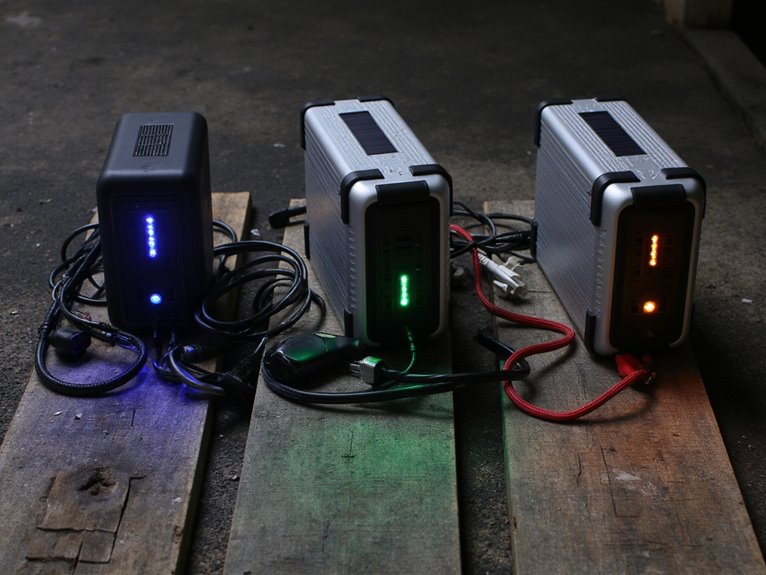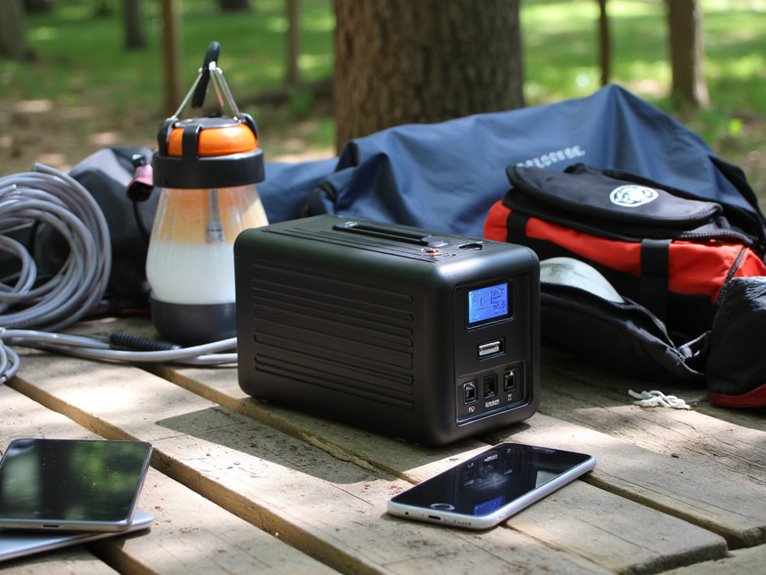How to Choose the Right Portable Power Station for Your Needs
You’ll need to calculate your daily power consumption by multiplying each device’s wattage by hours of use, then add a 20% safety margin for efficiency losses. Choose LiFePO4 batteries for longevity (2000+ cycles) over NCM types, and verify the station’s AC outlets, USB-C ports, and peak output match your devices’ requirements. Consider weight under 20 pounds for portability, multiple charging methods including solar compatibility, and select models with adequate port variety for simultaneous device operation—these foundational factors will guide you toward the ideal specifications.
We are supported by our audience. When you purchase through links on our site, we may earn an affiliate commission, at no extra cost for you. Learn more. Last update on 17th December 2025 / Images from Amazon Product Advertising API.
Notable Insights
- Calculate total daily energy needs by multiplying device wattages by usage hours, then add 25% safety margin.
- Choose LiFePO4 batteries for longevity (2000+ cycles) or NCM for higher energy density but shorter lifespan.
- Verify output specifications match your devices and check for sufficient AC outlets and USB ports needed.
- Balance capacity with portability by selecting units under 20 pounds for easy transport and mobility.
- Consider multiple charging options including AC wall, car, and solar panel inputs for maximum flexibility.
Calculate Your Power Requirements and Runtime Needs
Before you can select an appropriate portable power station, you must accurately calculate your total power requirements and determine how long you need your devices to operate on battery power. Start by identifying each device’s wattage from labels or manuals.
Accurately calculating your total power requirements and device operating duration is essential before selecting any portable power station.
Use this formula: Device Wattage × Hours Used per Day = Daily Energy Consumption in watt-hours.
Sum all devices’ watt-hour values to establish total daily power needs. Convert to kilowatt-hours by dividing by 1000 for cost calculations.
Your runtime estimation should include simultaneous device operation and extended use scenarios like camping or outages. If your device specifications list amperage instead of watts, convert to watts using the formula Watts = V x A, where V represents the voltage rating. Add a 10-25% safety margin above calculated requirements to account for conversion losses and efficiency reductions. This buffer prevents premature power depletion and maintains ideal battery health. Portable power stations operate on rechargeable batteries that eliminate the need for gas refills, making them particularly advantageous for frequent outdoor activities.
Compare Battery Technology and Essential Features

While you’ve calculated your power needs, the battery chemistry inside your portable power station determines its safety, lifespan, and long-term value.
LiFePO4 batteries offer superior battery longevity with 2000-3000+ cycles compared to NCM’s 500-1000 cycles. They provide better thermal stability, reducing overheating risks during heavy use.
NCM batteries deliver higher energy density, making them lighter for weight-sensitive applications. Emerging solid-state batteries provide enhanced safety by being immune to thermal runaways while maintaining lighter weight profiles.
Essential features matter equally. Look for multiple port options including AC, DC, USB-A, and USB-C PD outputs.
Solar input capacity ranges from 100W to 200W+—higher wattage means faster charging. Weight varies from under 7 pounds to over 20 pounds. Models like the Anker SOLIX C1000 demonstrate impressive recharge capabilities, completing a full charge in just 1.4 hours.
Consider expandability options, wireless charging capabilities, and built-in camp lights. Ruggedized construction and IP ratings improve outdoor durability.
Evaluate Output Options and Device Compatibility
The output configuration of your portable power station functions like a universal adapter that determines which devices you can power and how efficiently. You’ll need to match output specifications with your specific equipment requirements.
AC outlets deliver 100-240V for household appliances, while USB-C ports provide up to 140W through Power Delivery 3.1 protocols. USB-A ports typically max at 24W each. Car power outlets supply 12-27V DC for RV equipment.
Device suitability depends on voltage matching and continuous versus surge power ratings. Check if your station’s peak output handles motor startup surges.
Consider port quantity—stations offer 1-4 AC outlets plus multiple USB ports. DC outputs avoid inverter losses for compatible devices. Confirm simultaneous device support doesn’t exceed total wattage limits when powering multiple items concurrently.
Assess Portability and Build Quality
Since portability requirements vary dramatically between backpacking trips and car camping adventures, you’ll need to evaluate weight, size, and build quality against your specific mobility needs. Lightweight units under 20 pounds enable single-person carrying without strain during hiking. Heavier models offer larger capacity but require vehicle transport.
Ergonomic design greatly impacts usability. Look for sturdy handles with comfortable grips that reduce hand fatigue. Extendable handles with wheels help navigate uneven terrain for heavier stations. Consider compact dimensions that fit your gear bags or vehicle storage.
Build quality determines long-term reliability. Choose robust housing materials with dustproof and water-resistant ratings. Lithium-ion batteries outperform lead-acid alternatives in durability.
Achieving proper weight balance between capacity and portability depends on your intended usage scenarios and transport methods.
Determine Charging Methods and Budget Considerations
After selecting a power station that meets your portability requirements, you’ll face equally important decisions about charging methods and budget allocation.
AC wall charging delivers the fastest charging speed, ranging from 60W to 1800W input power depending on unit size. Car charging provides 12V DC convenience during travel but slower speeds due to amperage limitations. Solar panel charging maximizes sustainability impact while supporting off-grid operations, though weather conditions affect efficiency considerably.
Combined charging options allow simultaneous power inputs, reducing recharge times greatly.
Budget considerations span widely based on capacity and features. Entry-level models offer 100-300Wh at lower costs, while high-capacity units demand premium pricing.
Evaluate your charging environment priorities—grid dependency versus off-grid flexibility—alongside financial constraints to determine ideal feature combinations.
On a final note
You’ve now got the essential framework to select your ideal portable power station. Match your calculated wattage requirements with appropriate battery capacity. Prioritize LiFePO4 chemistry for longevity and safety. Verify output compatibility with your devices’ voltage and connector requirements. Balance weight against your mobility needs while ensuring robust construction quality. Consider your primary charging scenarios and budget constraints. These technical specifications will guide you to the right power solution for your specific applications.

